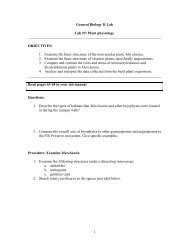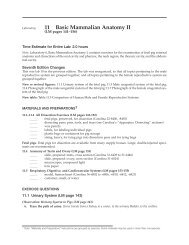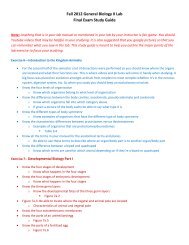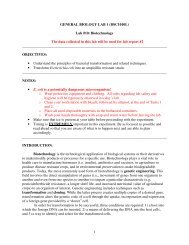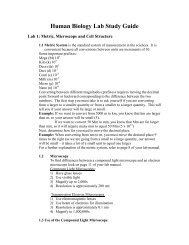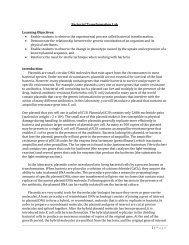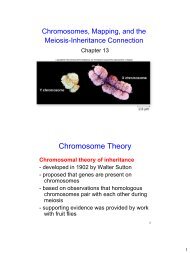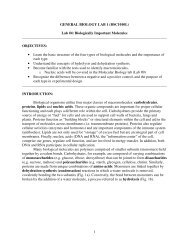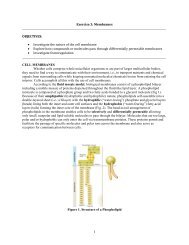Lab #7: Introduction to the Kingdom Animalia Objectives: 1 ...
Lab #7: Introduction to the Kingdom Animalia Objectives: 1 ...
Lab #7: Introduction to the Kingdom Animalia Objectives: 1 ...
You also want an ePaper? Increase the reach of your titles
YUMPU automatically turns print PDFs into web optimized ePapers that Google loves.
Level of<br />
organization<br />
Pro<strong>to</strong>plasmic Cellular Cell-tissue Tissue-organ Organ-system<br />
Description<br />
Representative<br />
group<br />
All functions<br />
are confined<br />
<strong>to</strong> a cell<br />
Protista<br />
(NOT part of<br />
kingdom<br />
<strong>Animalia</strong>)<br />
We will NOT<br />
look at <strong>the</strong>m<br />
<strong>to</strong>day.<br />
Aggregation<br />
of cells that<br />
are<br />
functionally<br />
differentiated<br />
Cells are<br />
aggregated<br />
in<strong>to</strong><br />
patters/layers<br />
= tissues<br />
Different<br />
tissues are<br />
organized in<strong>to</strong><br />
organs. More<br />
specialized<br />
than tissues.<br />
Organs work<br />
<strong>to</strong>ge<strong>the</strong>r <strong>to</strong><br />
perform a<br />
coordinated<br />
function<br />
Parazoa Radiata Bilateria Bilateria<br />
Example 1<br />
a. Phylum<br />
b. Genus<br />
c. common name<br />
a. Porifera<br />
b. Grantia<br />
c. Sponges<br />
a. Cnidaria<br />
b. Metridium<br />
c. Sea anemone<br />
a.<br />
Platyhelmin<strong>the</strong>s<br />
b. Dugesia<br />
c. Planarian<br />
a. Chordata<br />
b. Perca<br />
c. Perch<br />
Drawing of<br />
whole organism<br />
Slides<br />
CS Grantia



